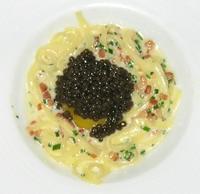Row 2: Tony Luke's Pork Italian; 5 Ninth's Cubano; 5 Ninth's Banh Mi
Row 3: Caracas; Chopiarepa; Comeflor Arepa

As Sandwich World Tour ended up being one of my favorite food adventures in New York, I figured I’d review it in the form of one of my favorite poems. Thanks Eliot.
"The Love Song of S. Wich Rockefeller"
Let us go then, Danny and I,
While the morning is spread across the sky,
Like a sandwich sliced on a cutting board.
Let us go, through less than deserted streets,
The enticing treats
Of restless tours in this great city,
And sandwich restaurants costing less than ten fifty:
Treats that follow like a brilliant argument
Of delicious intent
To lead you to an overwhelming question…
Oh, do not ask, “What is it?”
Let us go and make our visits.
In the classic sandwich shop the clients come and go
Talking of sandwiches made nice and slow.
SANDWICH ONE
RESTAURANT: Eisenberg’s Sandwich Shop
LOCATION: 174 Fifth Ave Ste 1
SANDWICH: Split a Turkey Reuben
PRICE: $4.50
The sauerkraut fog that rubs its back upon the rye bread panes,
The sliced turkey that rubs its muzzle on the rye bread panes
I licked my tongue into the corners of the seasoning,
Lingered upon the excess salt that was a bit of a drain,
Let fall upon my tongue the Swiss that comes from cows,
Slipped between the turkey and kraut, but couldn’t make the leap,
And seeing that it was only of mediocre might,
We only ate half as there were miles to go before we could sleep.
RATING: 6.0/10
SANDWICH TWO
RESTAURANT: Tony Luke’s
LOCATION: 576 9th Ave
SANDWICH: Split a Pork Italian
PRICE: $5.50 (with bottled water)
And indeed there was time
To walk the long distance to 9th Avenue where it crosses 42nd street,
Even in the hot sun, Tony Luke’s was worth the pains;
There was time, there was time
To prepare a Pork Italian like nothing else you could eat;
There will be time to indulge and salivate,
And time for all the broccoli rabe to cover your hands
That lift and drop the sandwich on your plate;
Time for you and time for me,
And time yet for a sliced pork decisions,
And for a hundred dreams and visions,
Of Tony Luke’s toasty sandwich mastery.
RATING: 8.5/10
Along 9th Avenue the bloggers come and go
Talking of Bahn Mi and Cubanos.
SANDWICH THREE
RESTAURANT: 5 Ninth
LOCATION: 5 9th Ave
SANDWICH: Split a Banh Mi and a Cubano
PRICE: $32.00 (with a margarita)
And indeed there will be time
To wonder, “Do I dare?” and, “Do I share?”
Time to eat two that are more than fair,
With more spicy red sauced pork prepared with care—
[They will say: “How Nicky’s is better, the real thing!”]
My agreement but 5 Ninth’s is still worth the bling
Do I share
Disturb the universe?
In a minute there is time
For Cubanos and infusion which it’s better not to reverse.
For I have known others already, known Cubanos all:—
The pork that fixes you in a contented haze,
And leaves me contented, and far from thin,
When I left 5 Ninth, I decided their Cubano should hang in a hall
Then how could I begin
To spit out all the deliciousness of my days and ways?
And how should I consume?
RATING: 7.5/10
SANDWICH FOUR
RESTAURANT: Caracas Arepa Bar
LOCATION: 91 East 7th Street
SANDWICH: Chopiarepa (Inspired on the "Choripan" (chorizo+baguette), this street delight arepa has grilled chorizos and cheddar cheese; also added plantains); La Comeflor (sautéed mushrooms with leek and aged cheese)
PRICE: $21.00 (with a Chicha Rice Drink and Half a Banana Milkshake)
And I hadn’t known the arepas already, never known them all—
Arepas that are corn crunched and yellow and blair
[But what in the world, nothing else to these do compare!]
It is spicy chorizo and nothing less
That makes me so ingest?
Arepas that lie along a table, or deserve to stand tall.
And should I then consume?
And how should I begin?
Shall I say, I have enjoyed arepas stuffed with meats
And watched the cheese that melts, oh what a sight
Or mushroom and leeks, falling out of their arepas windows?…
I should have been a pair of these amazing corn claws
Filling across my stomach, Caracas an infinite please.
RATING: 8.5/10
And the morning, the adventure, sandwiched so peacefully!
Grasped by my fingers,
Breaded … fried … oh it lingers,
Sandwiched forever, here beside Danny and me.
Should I, after Bahn Mi and Cubanos and Pork Slices,
Always want more sandwiches, oh what a crisis!









































